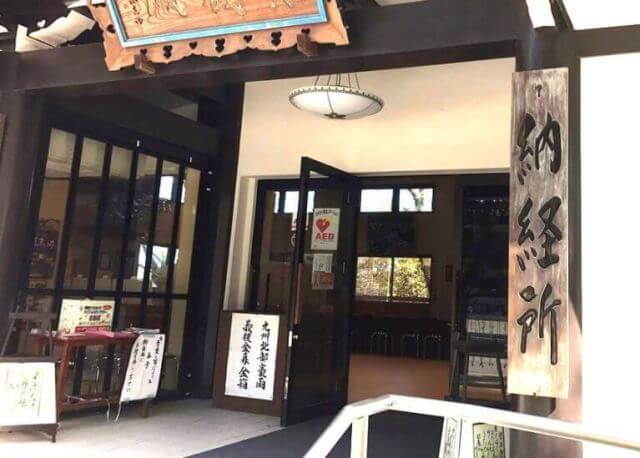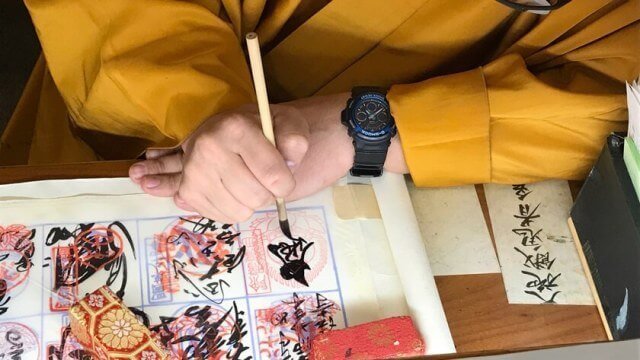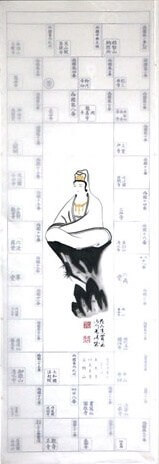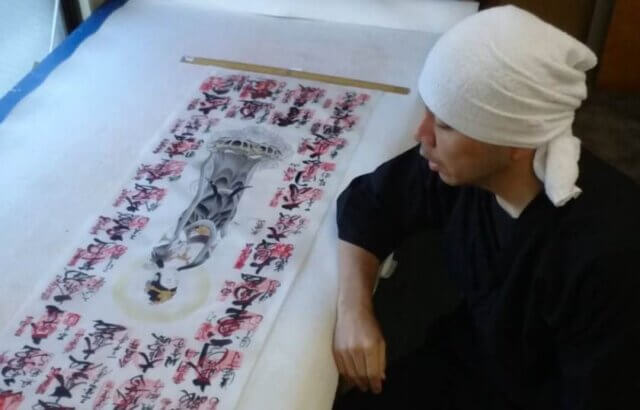Production of Saigoku 33 Kannon Pilgrimage Kakejiku Hanging Scroll

A Request from a Customer in the U.S. for the Production of Hanging Scroll of the Pilgrimage to the Thirty-Three Kannon Sacred Sites in Western Japan
Contents
- 1 Sacred Sites and Nōkyō-Jiku Hanging Scroll
- 2 A Request from a Customer in the U.S. for the Hanging Scroll Mounting of Nōkyō-Jiku of the Pilgrimage to the Thirty-Three Kannon Sacred Sites in Western Japan
- 3 Mounting Work
- 4 The Mounting Completed: Hanging Scroll of the Pilgrimage to the Thirty-Three Kannon Sacred Sites in Western Japan
Sacred Sites and Nōkyō-Jiku Hanging Scroll
Sacred sites mean places with miraculous virtue and refer to Shinto shrines, Buddhist temples, and other religious facilities and places associated with them that are considered sacred.
The representative sacred sites are “Eighty-eight sacred sites in Shikoku”, 88 temples related to Kōbō-Daishi Kūkai, spread throughout Shikoku, and the “Thirty-three Kannon sacred sites in western Japan” scattered throughout the six prefectures in the Kinki region and in Gifu prefecture.
Individual temples and shrines that compose a sacred site are sometimes called “札所, Fudasho (temple which issues amulets)”.
“Eighty-eight sacred sites in Shikoku” are well known even to people outside Japan, and many have visited them. But recently, more and more people came to Japan and visit thirty-three Kannon sacred sites in western Japan.
At each Fudasho, pilgrims visit its Nōkyōjo (temple office for receiving offerings or donations) and receive Goshuin, the temple’s stamp, on a nōkyō-chō (a book in which they collect the stamp of the hōin and the signature at each fudasho temple) or other materials. It is like a stamp collecting tour, which has gained its popularity.

Nōkyōjo
Pay a fee at Nōkyōjo, the sutra collection point, and have a red seal and the name of the temple written. The fee generally ranges from 300 yen to 500 yen. The price varies depending on the item to be written.

Normally, pilgrims have the Goshuin written and sealed on a specific notebook, and thus collect them.

However, this Goshuin collecting is also practiced with a hanging scroll. Pilgrims collect Goshuins on a piece of silk and later mount it on a hanging scroll. This silk is called “Nōkyō-Jiku”.
This Nōkyō-Jiku below is made of a piece of silk fabric, with a picture or letters printed (sometimes painted) only on the center, and a piece of paper, with names of Fudasho around. The fabric and paper are temporally glued together and consist of a piece of the mount. At the Nōkyōjo of each Fudasho, the priest in charge of Goshuin stamping writes and seals the Goshuin of their temple on the place specified on the mount.

Nōkyō-Jiku
The mount filled with Goshuins from all Fudasho will look like below. Pilgrims, with the mount in this state, will visit a hyōgushi scroll mounter like us to have it mounted on a hanging scroll. The hyōgushi scroll mounter detaches the silk fabric with Goshuins on it from the paper below and mounts it on a hanging scroll.

The Mount for Nōkyō-Jiku with All Goshuins Collected
This is the hanging scroll completed its mounting by a scroll mounter.

This time, we received a request from a customer in the U.S. for mounting Nōkyō-Jiku of his pilgrimage to the thirty-three Kannon sacred sites in western Japan into a kakejiku hanging scroll.
A Request from a Customer in the U.S. for the Hanging Scroll Mounting of Nōkyō-Jiku of the Pilgrimage to the Thirty-Three Kannon Sacred Sites in Western Japan
We heard that our customer, when staying in Japan for a long time in 2019, came to know the existence of the pilgrimage to the thirty-three Kannon sacred sites in western Japan, and started his pilgrimage.
He successfully collected all Goshuins on his Nōkyō-Jiku. Nonetheless, a sudden event made him return to the U.S. and he did not have time to get his Nōkyō-Jiku mounted on a hanging scroll. Therefore, he went back to the U.S. with his Goshuin mount.
Although he was planning to make a quick return to Japan, the global outbreak of the novel coronavirus made it difficult for him to come to Japan. And he spent his time questioning himself what to do with his Nōkyō-Jiku.
Then he came to know our company that receives orders from all over the world to produce hanging scrolls and decided to contact us.
Before, we have received an order from a person in Switzerland to mount a Nōkyō-Jiku of his pilgrimage to the eighty-eight sacred sites in Shikoku, which made this customer decide to communicate with us.
We gave him a rough idea of the minimum price required by email, and since it was within his budget, he agreed with our proposal and sent us the mount.
This is the silk fabric with all Goshuins collected that we detached from its mount.

After the arrival of the mount, we made it sure that he completed his pilgrimage (To tell you the truth, some customers, after their order placed, find that the mount lacks some Goshuins and want it back, which causes us trouble). Then, we discussed which hanging scroll we would mount it on.
We have about 20 standard courses to choose from, depending on customer’s budget. And we asked him to choose from them.
And for this order, we decided to use these fabrics below, the same ones with which we completed the request from the Swiss man to mount his Nōkyō-Jiku of his pilgrimage to the eighty-eight sacred sites in Shikoku.
Although gold thread is used in the fabric, it has a low luster. Therefore, it is not obnoxious or gaudy yet keeps dignity. It seems people outside Japan liked such texture of the product.
We received the payment and now let’s move on to the mounting process.
Mounting Work
We are on the mounting work.
The Mounting Completed: Hanging Scroll of the Pilgrimage to the Thirty-Three Kannon Sacred Sites in Western Japan
After a long process, the hanging scroll of the pilgrimage to the thirty-three Kannon temples in western Japan was finally completed.

We mounted the product on the fabric chosen by our customer, which gave a majestic atmosphere to the completed work that is very prestigious.
Our customer has been waiting long for the completion of this product. Therefore, we reported to him its finalization and shipped it immediately.
He, having the long-waited product at hand, thanked us saying:
“I completed my pilgrimage and have waited for more than one year to have this Nōkyō-Jiku at hand. This is far better than I have imagined to be. I am very pleased to have this work in my possession.”
We are so glad that we could live up to our customer’s expectation.
We also attend world-widely to the mounting of Nōkyō-Jiku like the one above.
We have a variety of courses to choose from. If you have any requests, please feel free to contact us.





